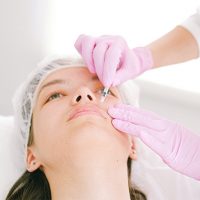
Whether it’s for detecting disease or donating, getting blood drawn is never a pleasant procedure.
If you think about it, extracting blood from your system must, in any amount, leave you a bit queasy and vulnerable, at least for some time.
This brings us to questions – Can you exercise after a blood test? How long should you actually wait to hit the gym?
Here are some facts and experiences about blood testing, exercising, and how they should(n’t) be combined.
Table of contents:
- Exercising after getting blood drawn
- How long after a blood test can I exercise?
- Exercise after a fasting blood test
- Can you lift weights after a blood test?
- What happens if you lift heavy after a blood test?
- Swimming after the blood test
- Running after the blood test
Exercising after getting blood drawn – not a good idea
While various clinics, doctors and nurses who perform phlebotomy recommend different resting periods after a blood draw, the common opinion is that patients should restrain from vigorous physical activity right after the procedure.
In fact, most phlebotomists suggest a 48-hour self-monitoring period that also includes resting and drinking lots of fluids, mostly to avoid dizziness and nausea which are quite common.
What then makes exercise so questionable after venesection?
Knowing some of the physiological effects of physical activity (raised blood pressure, excessive sweating, increased blood volume, cardiorespiratory strain, etc.) it is clear that stepping on a treadmill or lifting weights right after your venipuncture may indeed cause some room spinning.
A study on the effects of phlebotomy has discovered that engaging in high-intensity exercise (like cardio) after a routine blood donation (around 400 ml of blood) shows drops in hemoglobin levels and oxygen levels, as well as reduced exercise capacity for at least 2 days after the blood draw.
That said, there are no clear indications that exercising can cause any serious health problems or side effects apart from temporary body exhaustion and light-headedness.
Nevertheless, following professionals’ advice and recommendations will keep you safe from any potential worries.
How long after a blood test can I exercise?
The general hospital attitude is that at least 24 hours are needed of activity-free resting, especially avoiding strenuous lifting with the venipunctured arm.
Similarly, The American Red Cross, for instance, recommends avoiding any physical activity for the rest of the day to stay on the safe side.
With blood donation, things are even more serious, as there are greater chances of feeling lightheaded and weak, so most blood transfusion services recommend staying away from weightlifting, high-intensity workouts, or any kind of straining activities that could add to the dizziness.
Exercise after a fasting blood test
A fasting blood test is a regular blood draw but with at least 12 hours of strict fasting before the procedure.
With only water allowed, you shouldn’t also drink alcohol for at least 24 hours prior to the procedure, as well as avoid exercise and heavy lifting.
This kind of phlebotomy is performed for testing cholesterol, glucose levels and similar, since food and drink intake may compromise the normal hormonal balance and influence the chemical composition of blood.
What makes this dangerous for avid gym goes is the added fasting to the already tiring blood draw.
Before you decide to pump back up on your cardio, make sure to eat and drink lots of fluids after the procedure, followed by the recommended 24-hour rest.
Can you lift weights after a blood test?
Even more alarming than pure exercise, lifting weights is a strict no-no after phlebotomy.
Not only is it strenuous to the whole body, but it also puts pressure on the venipunctured arm that is still too vulnerable.
Muscle contractions in the arm pressure the punctured vein, improving blood circulation and volume, thus making it easy for the puncture to rupture or bruise. Possible side effects are bruising, arm pain, dizziness, and nausea.
What happens if you lift heavy after a blood test?
Just like weight lifting, any kind of anaerobic activity that involves swift and strong bursts of energy release is potentially hazardous.
Most after-phlebotomy recommendations strictly forbid heavy lifting (even more than exercising) due to the strain and pressure it creates on the veins.
Heavy resistance activities like lifting can cause a temporary increase in blood pressure which can, apart from the pressure on the venipunctured arm, lead to nausea, shortness of breath, muscle weakness, grogginess, etc.
In conclusion, it’s safe to say that if you had phlebotomy, you might want to wait for moving your couch for at least tomorrow.
Swimming after the blood test
Swimming can be considered light to high-intensity cardio activity, and thus also goes under the category of forbidden activities for at least a day after a blood test.
Swimming in hot water or interchangeably hot and cold (for example, a hot bath followed by a cold shower) can also cause additional problems.
The sudden rise or fall in body temperature boosts blood flow, improving circulation and increasing blood volume.
This, again, could cause unpleasant lightheadedness, nausea, muscle weakness, etc.
Running after the blood test
Finally, is running considered safe after a blood test?
Not exactly. If we follow the principles of cardio effects on the body, running and jogging are also in the danger zone after a blood draw.
Running pumps the blood flow, improves circulation, promotes sweating and strains the muscles – all not recommended right after a venipuncture.
All in all, avoiding the gym, cardio activities, weight lifting, or any kind of intensive body exhaustion is the smartest and safest decision.
After a 24-hour rest, combined with lots of fluids and healthy meals, you can get back on track with your running sessions, fully recharged and ready.

